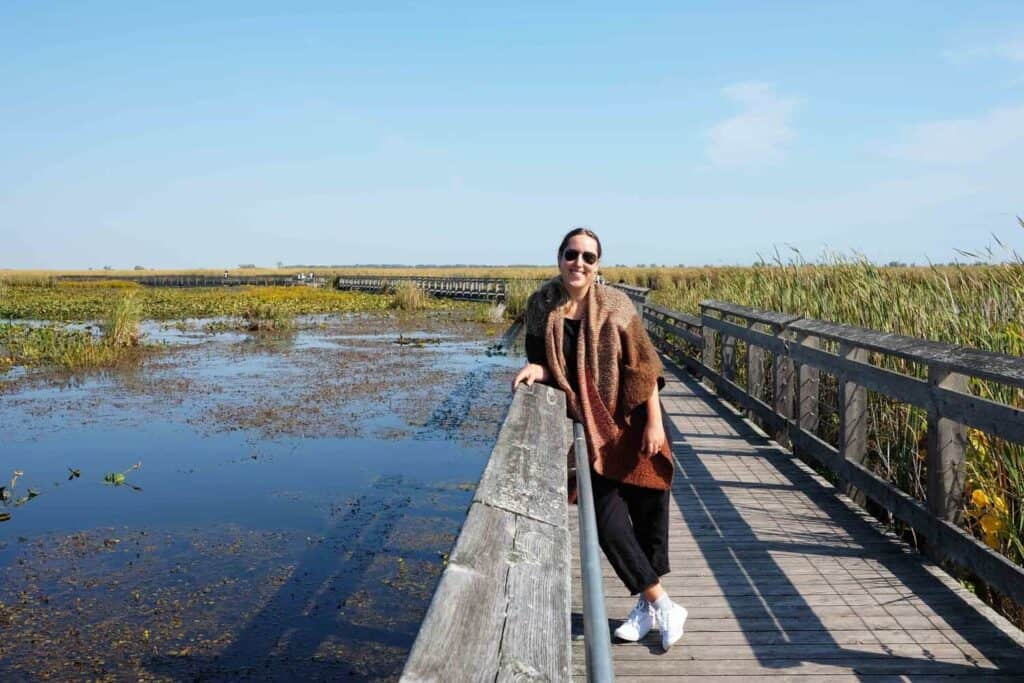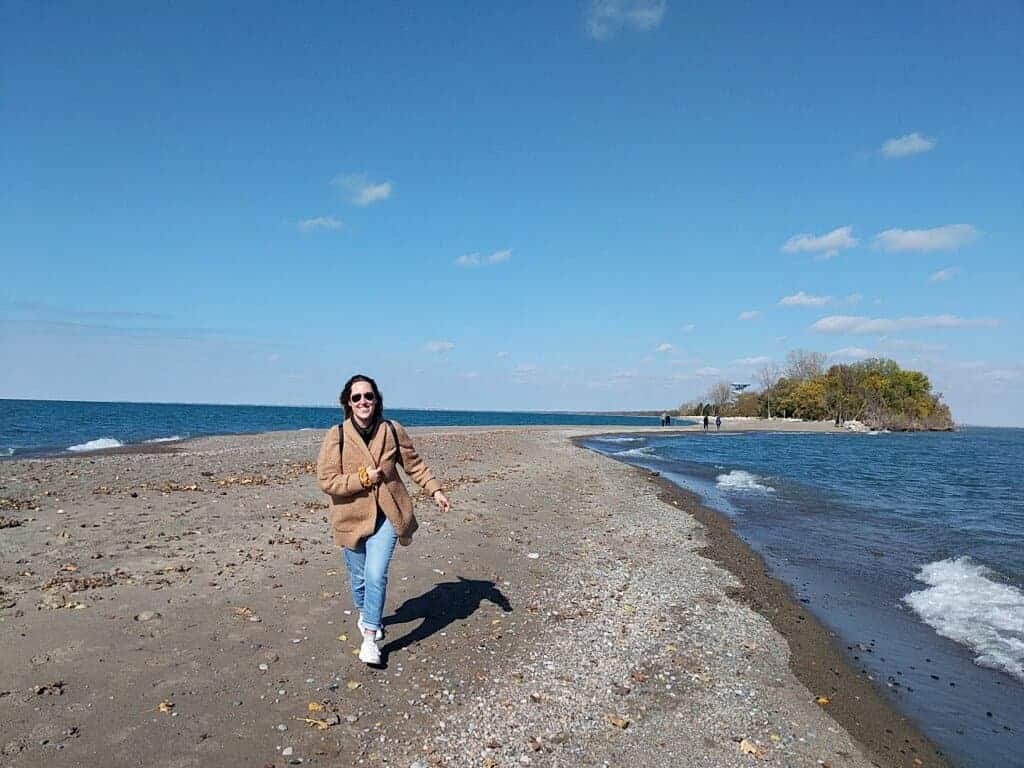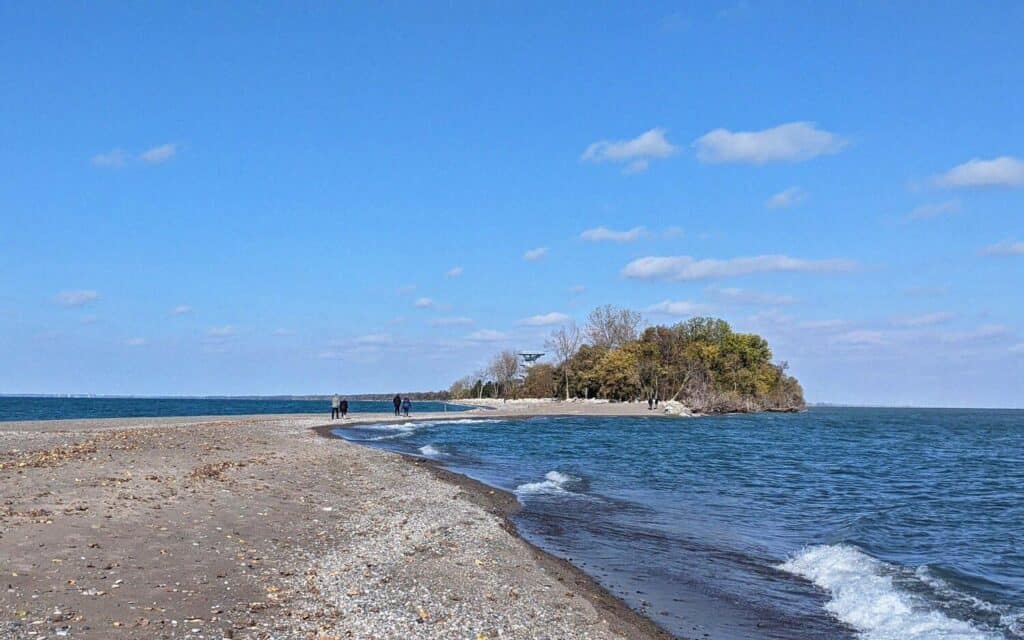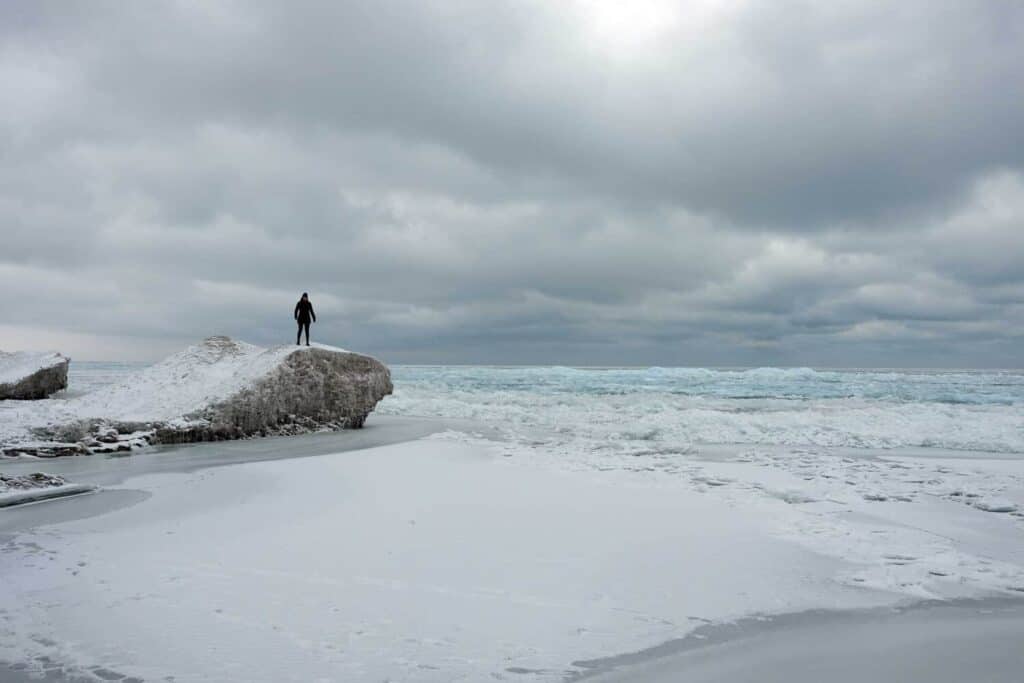Last Updated on July 29, 2025
Point Pelee National Park is at the most southern point in Ontario, known as “the point” because of the way that it stretches out into Lake Erie. But this unique sandy stretch isn’t the only thing that makes Point Pelee special. This park is known for its mix of marshes, beaches, and Carolinian forest. It’s also one of the best birdwatching spots in North America, especially during spring and fall migration.
Whether you visit during the sunny summers, fall migration season, or chilly winter, Point Pelee National Park always offers lots of interesting things to do.
This guide covers everything you need to know for a visit to Point Pelee, along with 8 things to do in the park.
- Why You Should Visit Point Pelee National Park
- How to Get to Point Pelee National Park
- Entrance Fees, Parking, and Accessibility at Point Pelee
- Where to Stay in Point Pelee National Park
- Best Time to Visit Point Pelee National Park
- 8 Things to Do in Point Pelee National Park
- 1. Visit The Tip of Canada at Point Pelee National Park
- 2. Enjoy One of Point Pelee’s Hiking Trails
- 3. Visit The Historic DeLaurier House
- 4. Go Swimming in Point Pelee National Park
- 5. Go Paddling in Point Pelee National Park
- 6. Enjoy Watching Bird Migrations at Point Pelee
- 7. Go Stargazing in Point Pelee National Park
- 8. Consider Visiting Point Pelee in the Winter
- Final Thoughts: Why You Should Visit Point Pelee National Park
- Point Pelee National Park FAQ

Why You Should Visit Point Pelee National Park
What makes Point Pelee especially unique is the fact that this Ontario park is actually a peninsula that tapers out into a long, sharp point, surrounded by the waters of Lake Erie. The name of the park “pelée” is French for “bald point.” It earned this name in the 1600s, when French explorers called it pelée because of the region’s lack of vegetation.
But before Europeans discovered the park, it was home to First Nations. Point Pelee National Park is located on the traditional territory of the Anishinaabe, Haudenosaunee and Miami peoples. As early as 600 CE, First Nations had summertime settlements around the park’s marshlands.
Up until the 1920s, members of the Caldwell Nation lived at Point Pelee. But in 1922, the Royal Canadian Mounted Police (RCMP) forcibly evicted Caldwell Nation from the park. They were told to leave, taking nothing but their children. The RCMP destroyed the Caldwell Nation’s root cellars so that they would have nothing to return to.
In 1918, Point Pelee National Park was officially created. It’s since become a popular spot for camping, swimming, hiking, cycling, bird watching and stargazing. And, after reaching “the tip” of the park, which is as far out on the peninsula as is possible to go, visitors can say that they have officially stood on the most southern mainland point in Canada. This point is so south, it’s actually further south than the most northern border of California!

At 1,564 hectares (6 square miles), Point Pelee is Canada’s smallest national park. Comparatively, Algonquin Park, which is further north in Ontario, is 763,000 hectares! Point Pelee may be small, but don’t let its size fool you. The park’s unique ecology and location makes it one of North America’s most renowned spots for birdwatching. In the spring, you can watch bird and butterfly migrations.
Throughout summer, the park is a fantastic swimming spot, and you can enjoy paddling through it’s marshes. Year round, you can enjoy hiking Point Pelee’s trails and boardwalks, or spend an evening star gazing. The park was designated as a Dark Sky Preserve by the Windsor Centre of the Royal Astronomical Society of Canada in 2006. I’ll go into detail about all of these activities, later in this guide!

How to Get to Point Pelee National Park
Point Pelee is in Essex County in southwestern Ontario, Canada. The park is just an hour from the city of Windsor, and about 3.5 hours from Toronto. If you’re coming from the United States, the closest city is Detroit, Michigan.
Although some Canadian parks (like Algonquin Park, for example) are accessible by public transport services, Point Pelee is not. The only way to reach the park is by car.
How to Get to Point Pelee from Windsor or Detroit
From Windsor (and Detroit, just across the river from Windsor), it’s a 65 kilometer drive to Point Pelee. You’ll follow the ON-3 East to Essex 33 in Leamington. Then, follow Essex 33 to Point Pelee Drive to enter the park.
How to Get to Point Pelee from Toronto
The drive from Toronto to Point Pelee is about 355 kilometers. You’ll hop on the ON-403 West, eventually merging into the ON-401 West. Take exit 63 from the ON-401 onto Chatham-Kent Country Road 1. When you reach Wheatley, take County Rd 34 West and Mersea Road 12 to Point Pelee Drive in Leamington.

Entrance Fees, Parking, and Accessibility at Point Pelee
Before we dig into the fun stuff, let’s cover some of the important things to know about visiting Point Pelee.
Point Pelee Entrance Fees
In 2025, entrance to Point Pelee National Park is free from June 20 to September 2 thank to the Canada Strong Pass. You don’t need to sign up for the pass or anything! Just show up at the park, and you’ll get in for free.
Outside of that period, regular admission fees apply. Typically around $9 CAD per adult, with discounts for youth, seniors, and families. Entry is free year-round for Indigenous Peoples and holders of Parks Canada Discovery Passes.
You can see the most up to date fees, here.

Parking at Point Pelee
Parking is included with your entrance fee. The park has a capacity of over 1000 vehicles. Parking is available at the Visitor Centre, Marsh Boardwalk, Group Camping Area, DeLaurier and at all picnic and beach facilities.
Accessibility at Point Pelee
The park provides wheelchair accessible washrooms at several sites (Blue Heron, The Tip, and the Visitor’s Centre). Blue Heron picnic site and Northwest Beach also provide accessible parking, picnic tables, washrooms and barbecues. An all terrain wheelchair is available for free reservation at the Visitor Centre and at the Marsh Boardwalk from June – September. The park also provides closed-captioned theatre programs and an FM broadcast system at the Visitor Centre.

Where to Stay in Point Pelee National Park
You’ve got many options for staying overnight, either in the park, or nearby. Here’s a list of your best choices:
Stay Inside Point Pelee National Park
If you’d like to stay inside the park while visiting Point Pelee, you can book an oTENTik from Parks Canada. An oTENTik is a unique accommodation that is convenient and comfortable. Similar to glamping, when you book oTENTik most of the supplies you need to camp are provided. The oTENTik itself is a permanent shelter on a raised wooden platform, and the structure looks like an A-frame cabin or prospector tent.
There are 24 oTENTik in the middle of Point Pelee Park, forming a little camp known as Camp Henry. Each site comes with four twin sized and one double sized bed, a table and chairs, dishes and cookware, cooking equipment, a gas stove or wood stove, and more. If you book one of these sites for your visit, you’ll have a great base to explore the park from. You can book an oTENTik on the Parks Canada website.

Book a Camping Site Near Point Pelee
There is no option for tent camping inside Point Pelee National Park. If you prefer tent camping, you can book a camping site at Wheatley Provincial Park, which is just a 22 minute drive from Point Pelee. Wheatley Provincial Park has four campsites that have both electrical and non-electrical sites. Learn more about their camping facilities, here.

Book a Waterfront Cottage Near Point Pelee
The Rose Cottage is a freshly renovated lakehouse that sits on the shores of Lake Erie. I spent a few days staying in this cottage, and I was blown away by it’s perfect balance of modern comforts and cottage life. It is nicely updated with all the amenities for a fancy stay: fireplace, lounging areas, big kitchen, two bathrooms, four bedrooms, tv and fast internet! The cottage is spacious, and from nearly every room you’re treated to beautiful views of the lake.
Rose Cottage is just a 6 minute drive from Point Pelee, making it a super convenient place to stay while visiting the park. After a busy day at the Point, you can come back to the Rose Cottage to watch the sunset from muskoka chairs on the deck. Also nearby the Rose Cottage are restaurants, groceries, and more in Leamington. You’re also within driving range of many wineries, breweries, and golf courses.
You can book the Rose Cottage, here.

Stay in a Historic Leamington Inn
The Seacliffe Inn is a historic waterfront inn with big, cozy rooms and a great location. It’s just a 10 minute drive from Point Pelee National Park.
Apart from its cute and comfy rooms, Seacliffe Inn is home to Thirteen at the Inn, a casual fine dining restaurant and a cocktail bar. You’ll want to dress up and head down to their patio in the evening to enjoy a seafood dinner – while watching a beautiful sunset over the lake. Be sure to try their secret, custom cocktail – the Seadog!
The Seacliffe Inn is an independently-owned hotel, which is always my first choice for accommodations. Supporting local businesses is a great way to travel responsibly, because it enables you to give back to the communities you visit.

Best Time to Visit Point Pelee National Park
Point Pelee’s southern location makes it a great park to visit year round. During the summer months, the warm weather makes it a perfect spot to go swimming, hiking, and paddling. In the winter months you can expect chilly weather, but the park’s trails are still accessible and the snow makes for a beautiful winter wonderland.
During the spring and the fall, Point Pelee’s weather is moderate, and if you come during these transition seasons you can view bird and butterfly migrations! I’ll cover how to visit Point Pelee for bird migrations, a little later in this guide.

8 Things to Do in Point Pelee National Park
Ready to visit this beautiful Ontario park? Here’s 8 things to do in Point Pelee National Park.
1. Visit The Tip of Canada at Point Pelee National Park
Despite having visited Point Pelee Park many times, I can never skip trekking out to The Tip. The experience of hiking through the sand to the very edge of the peninsula is exciting, and it’s an awesome spot for photos.
The Tip is the very spot where Point Pelee’s sandy beaches stretch the furthest out into Lake Erie. The peninsula extends into a slender, sharp point. Once you reach that spot, you’re as south as you can go in mainland Canada!
To reach The Tip, you’ll park at the Visitor Centre. From there, you can catch a free shuttle that takes you to the start of the Tip Trail. From there, it’s about a 1 kilometer walk to The Tip. When the shuttle isn’t operating, you can walk from the Visitor’s Centre to the Tip Trail. Most of the Tip Trail is paved, making it an easy walk. Once you reach the end of the pavement, you’ll have to walk on sand to reach the most southern point.
The shuttle drops you off at The Tip’s outdoor exhibit, which operates from April to October. You can also climb the point’s new observation tower! The observation tower is four stories high, so it’s quite a climb. But the views are worth the effort. The observation tower is found at the start of the Tip Trail.
It’s important to caution that you do not swim or wade at The Tip. The water is often choppy, and at this sandy tip two dangerous currents converge. Over the years several lives have been lost at The Tip, so it’s important to take this precaution seriously. In fact, entering the water at The Tip is a fineable offence, up to $10,000. Stay safe!

2. Enjoy One of Point Pelee’s Hiking Trails
Point Pelee has several walking trails that range in length, from 1 kilometer loops to longer trails. Because the point is quite flat, none of the trials are especially challenging. You can likely fit a couple of them into one day, giving you the opportunity to explore marshland, beaches, and forest. When you arrive at the park, you can request a park map that outlines all of it’s trails. Or, download park maps to your phone for free, save paper!
At 4 kilometers, Chinquapin Oak Trail is one of the longest routes in the park. As per its name, the trail brings you through a forest of Chinquapin oak trees. If you’d like to plan a longer hike, you can consider connecting to the Tilden Woods Trail (1 kilometer loop), or the DeLaurier Homestead & Trail (1.2 kilometer loop).

The Marsh Boardwalk is an absolute must-do trail at Point Pelee. This 1 kilometer floating boardwalk brings you through marshy wetlands. At the start of the trail is an observation tower that provides a beautiful aerial view. As you walk on the boardwalk, you’ll come across telescopes that you can use to spot wildlife.
You also have the option to bring your bike and cycle the Centennial Bike & Hike Trail. It’s a 4 kilometer trail that brings you through forest and alongside beaches. Just beware that this trail is not a loop. If you cycle (or walk) the 4 kilometers, make sure you’ve got the energy and time to make the trip back.

3. Visit The Historic DeLaurier House
The DeLaurier House was first occupied by Oliver and Esther DeLaurier and their family in the 1850s. Oliver DeLaurier originally constructed the house between 1851 and 1861. Over the following decades, the home was somewhat modified, for example, an attached greenhouse was added in the 1950s.
The DeLaurier house remained a home for DeLaurier’s descendants up until 1966. The house, which is now an important heritage site, is a unique reminder of the history of human settlement within Point Pelee National Park.
The homestead is easily accessible within the park. There is parking available just a short walk from the house. While you’re there, I recommend walking the DeLaurier Homestead Trail. It’s a 1.1 kilometer loop that brings you first to the house. There you can admire the still standing structure, and read signage that teaches you more about the history of the property.
Then, the trail will bring you through marshland, partially on boardwalks. As you walk the trail, signage explains the impact that the DeLauriers and others living in the park had on the ecology of the marsh. It’s a fascinating story of how human settlement shapes the land we live on.

4. Go Swimming in Point Pelee National Park
Point Pelee is a fantastic destination for a relaxed beach day filled with swimming and sandcastles. The park has 20 kilometers of sandy beaches on both the west and east sides of the peninsula. The two most popular beach areas are Northwest Beach and West Beach. These are good spots for a beach day because they provide washrooms, change rooms, picnic tables and other facilities. Note that there are no lifeguards at Point Pelee’s beaches.

While swimming is accessible and safe on most of Point Pelee’s beaches, you must not swim at the southern point (The Tip). At the park’s famous tip, the water is often choppy, and it’s there that two dangerous currents converge. It is not safe to even wade in the water there. Over the years several lives have been lost at The Tip, so it’s important to take this precaution seriously. In fact, entering the water at The Tip is a fineable offence, up to $10,000.

5. Go Paddling in Point Pelee National Park
Two thirds of Point Pelee Park are made up of wetlands. Throughout the park you’ll notice many areas of marsh and ponds, connected by channels. You can spend a solid day navigating through the quiet maze of marshland. You’ll spot many different kinds of birds, as well as unique flora.
The access point to the marshes is at Marsh Boardwalk. Bring your own equipment, or rent a kayak or canoe from the Friends of Point Pelee National Park outpost there. Check out their rates and info here.
I also recommend going on the Point Pelee National Park freighter canoe tour! On this tour, you get to hop into a big canoe that is steered by a Parks Canada interpreter, and so you don’t need to have any experience. You can just show up and enjoy the ride!
You get to explore parts of the park that are only accessible by water, learn about the marsh’s role in the local ecosystem, and spot wildlife like birds, turtles, and if you’re lucky, a beaver! We learned from our Parks Canada guide that the marsh is home to a population of 10-20 beavers.
This freighter canoe tour is an easy and educational way to experience the Point Pelee National Park from a close-to-the-water perspective. Just be sure to bring some bug spray because there’s lots of flies around! This is just one of the many awesome locations to go paddling in Windsor-Essex.

6. Enjoy Watching Bird Migrations at Point Pelee
There are two times of year that you can watch bird migrations at Point Pelee: in the spring and the fall. Each year, more than 390 species of birds stop in the park as they migrate south for the winter (or back north for the summer). You can spot in the forests of Point Pelee species of birds that aren’t seen anywhere else in Canada!
Each May, Friends of Point Pelee and Point Pelee National Park host the Festival of Birds. If you’re interested in learning about the bird migrations this is a wonderful time to visit the park. The festival organizes bird hikes, guest speakers, presentations and workshops.

You can learn the finer points of bird identification, discover local flora, check out local hotspots and learn about efforts to restore habitat for birds in the region. For those who are new to birding, there is a Birding 101 program!
Point Pelee is also known for being a stop-over point for millions of monarch butterflies as they travel to Central America for the winter. Early autumn is the best time to spot the butterflies. While you can spot the butterflies during the day, if you go in the evenings or early mornings you’ll be able to spot them in the trees roosting.

7. Go Stargazing in Point Pelee National Park
Point Pelee is a designated Dark Sky Preserve, which means that the park is one of the best places to admire the night sky in Canada. During the night, the sky glows from the light of millions of visible stars.
The best way to enjoy the night sky views is to book a stay in the park overnight, in one of the oTENTiks. Your other option is to plan your visit for one of the designated viewing nights. Every month, Point Pelee holds Dark Sky Nights. They are held on the best night sky viewing dates, based on the new moon.
On Dark Sky Nights the park is open until midnight, meaning you can drive in for the evening if you’ve opted to stay in accommodations outside of the park. You can see the dates for designated viewing nights, here.

Here are some tips for getting the most out of your stargazing experience:
- Bring binoculars, or a telescope!
- Avoid contributing to light pollution by minimizing excessive light. Turn off flashlights when they aren’t in use, and put a red cellophane over your flashlight. Red light helps you retain your night vision, and contributes less to light pollution.
- Pick up a seasonal star chart at the park’s gate entrance when you arrive.
- Check the weather before heading out. A cloudy night might lower visibility.
- Download a stargazing app to your mobile phone.
- West Beach and the Visitor Centre parking lot are the best car-accessible stargazing locations.

8. Consider Visiting Point Pelee in the Winter
Visiting Point Pelee National Park in the winter is a special experience! The park’s trails become a wonderland of snow, and the beaches and shores of the peninsula become blanketed by sheets of ice. All throughout the park, you’ll spot gorgeous ice formations that develop on trees and driftwood.
From late December to late March, Point Pelee becomes quite windy and chilly, so if you decide to visit during this time be sure to bundle up warmly. Also note that during the winter months, the park is open only from 7:00am to 7:00pm.
Final Thoughts: Why You Should Visit Point Pelee National Park
In my many visits to Point Pelee National Park I’ve learned that this park is a favorite spot amongst local residents in southern Ontario. It’s easy to understand why. This park has unique wildlife and landscapes that aren’t found in other parts of Ontario, or Canada. And, Point Pelee offers something for everyone, from hiking and history to a lazy day on the beach.
Point Pelee National Park FAQ
Does Point Pelee National Park have camping?
There is no tent or RV camping in Point Pelee National Park, but it’s possible to book on of the park’s prospector tents to stay in the park overnight. Alternatively, camp at the nearby campground within Wheatley Provincial Park or at Campers Cove Campground.
What is Point Pelee National Park known for?
What makes Point Pelee unique is that the park is a peninsula which tapers out into a long, sharp point, surrounded by the waters of Lake Erie. Point Pelee is home to more than 390 bird species, 70 species of trees, and the ‘Tip’ of the park is the southernmost point of Canada’s mainland.
Are dogs allowed at Point Pelee National Park?
Yes, dogs are allowed in all areas of Point Pelee National Park, but they must remain on leash.
Want to read more about Ontario?
- 14 of the Best Ontario Parks to Explore
- Why You Need to Visit an Alpaca Farm in Ontario
- A First Timer’s Guide to Exploring Algonquin Provincial Park
- How to Go Glamping in Algonquin Provincial Park
Like this post? Pin it!



